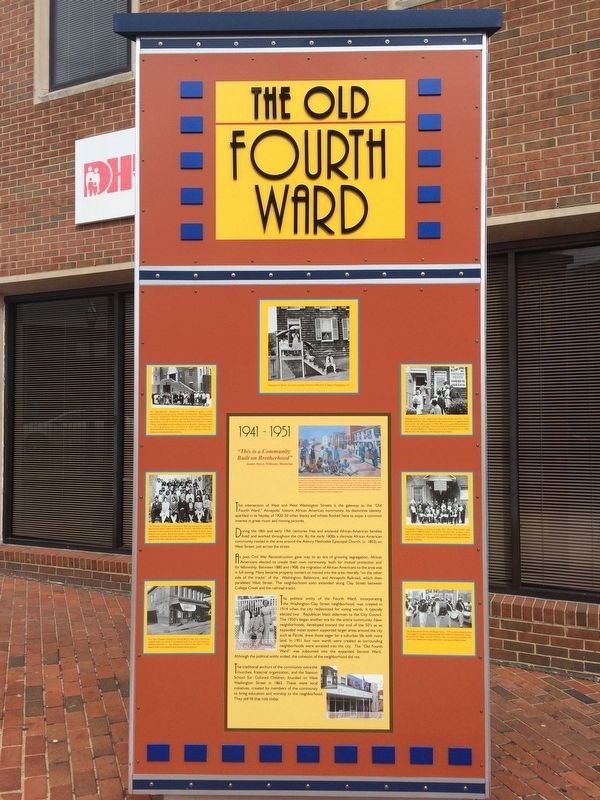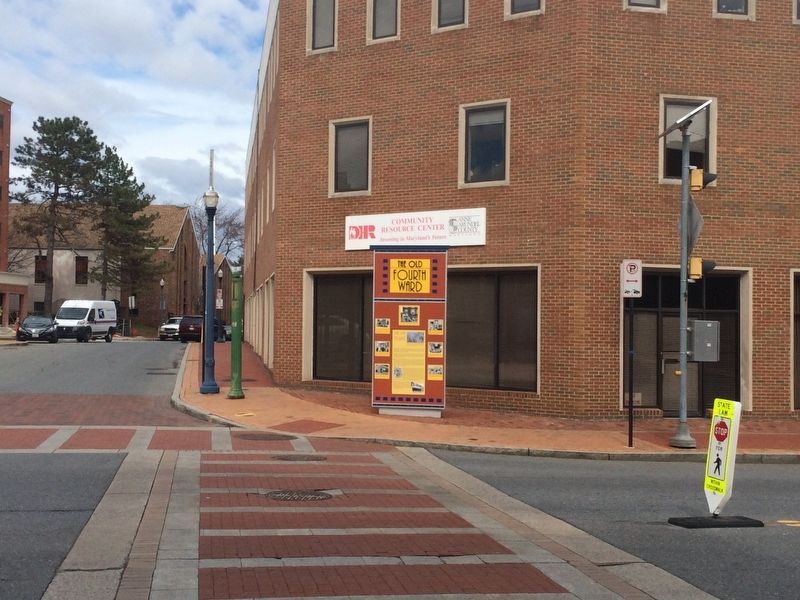Annapolis in Anne Arundel County, Maryland — The American Northeast (Mid-Atlantic)
The Old Fourth Ward
1941 - 1951
"This is a Community Built on Brotherhood"
Janice Hayes Williams, Historian
This intersection of West and West Washington Streets is the gateway to the "Old Fourth Ward," Annapolis' historic African American community. Its distinctive identity sparkled in its heyday of 1920-50 when blacks and whites flocked here to enjoy a common interest in great music and moving pictures.
During the 18th and early 19th centuries free and enslaved African-American families lived and worked throughout the city. But the early 1800s a discrete African American community rooted in the area around the Asbury Methodist Episcopal Church, (c. 1803) on West Street, just across the street.
As post Civil War Reconstruction gave way to an era of growing segregation, African Americans elected to create their own community, both for the mutual protection and for fellowship. Between 1880 and 1908, the migration of African Americans to the area was in full swing. Many became property owners or moved into the area--literally "on the other side of the tracks" of the Washington, Baltimore, and Annapolis Railroad, which then paralleled West Street. The neighborhood soon extended along Clay Street between College Creek and the railroad tracks.
The political entity of the Fourth Ward, incorporating the Washington-Clay Street neighborhood was created in 1914 when the city redistricted for voting wards. It typically elected two Republican black alderman to the City Council. The 1950's began another era for the entire community. New neighborhoods, developed toward the end of the 50's as an expanded water system supported larger areas around the city such as Parole, drew those eager for a suburban life with more land. In 1951 four new wards were created as surrounding neighborhoods were annexed into the city. The "Old Fourth Ward" was subsumed into the expanded Second Ward. Although the political entity ended, the cohesion of the neighborhood did not.
The traditional anchors of the community were the churches, fraternal organization, and the Stanton School for Colored Children, founded on West Washington Street in 1865. These were local initiatives, created by members of the community to bring education and worship to the neighborhood. They still fill that role today.
[Captions:]
You can see several community icons in this mural of the "Fourth Ward, Circa 1940", including Asbury Methodist Episcopal Church on West Street and the Washington Hotel where entertainers played during the 1940s. Community residents posed for this 2004 mural by Cynvia Rankin and Diane Monday. The multi panel painting was funded by the City of Annapolis Art in Public
Wiley Bates shown with his wife Annie and Miss May Ella Watkins, a school teacher. Bastes became a key political figure and philanthropist of the community. Bates High School, now Bates Heritage Center, and Bates Middle School were named in his honor. Unknown photographer, Wylie H. Bates and Family. MSA SC 2010-1-25, Collection of Maryland State Archives.
The Stanton Center retains its central role in the community. You can visit the historic classroom at Stanton Community Center at 92 Washington Street, and enjoy their community programs throughout the year. Karen Engelke, Stanton Center 2007.
As segregation deepened, the community grew, firmly anchored by its growing number of churches. Among them were St. Augustine's Catholic Church and First Baptist Church on West Washington Street. St. Philip's Episcopal Church on Northwest Street and Mt. Moriah AME on Franklin Street. These congregations provided spiritual growth, sanctuary, and a training ground for community leadership. Unknown photographer, St Augustine Sodality, 1954. MSA SC 2140-1-407, Collection of the Maryland State Archives.
The Stanton School was founded in 1865 by community members. Named for Edwin Stanton, President Lincoln's Secretary of War and founder of the Freedman's Bureau that was created to assist newly freed former slaves, the school quickly became a community anchor. Henderson, Stanton High School, Students and Faculty on Steps, 1930. MSA SC 2140-1-277, Collection of the Maryland State Archives.
The Star Theater, owned by Levine family, was the only movie theater open to blacks in Annapolis well into the 20th century. Howard Hayman, Sr., Star Theater on Calvert Street, April 5, 1935. MSA SC 2140-1-674, Collection of the Maryland State Archives.
Helping Hand, Inc., an organization launched by Rev. and Mrs. Floyd Snowden and Mrs. Marian Satterthwaite, epitomized the neighborhood character for thirty years (c. 1960s-90s) that it provided emergency shelter, food and clothing, counseling and other services to those in need. Thomas Baden, Jr., Headquarters of the Helping Hand, c. 1968. MSA SC 3544-1-02, Collection of the Maryland State Archives.
Annapolis Masonic Universal Lodge, No. 14 on Clay Street, was organized in 1864 by black veterans of the Civil War on their return from New England. It was the only integrated fraternal organization in the City at the time. Courtesy of Annapolis Masonic Lodge No. 14, Jeffrey Henderson, Historian.
The Annapolitans Drum and Bugle Corps, 1970, at the annual Ancient City Lodge #175 Elk's Organizational Day Parade on Northwest Street, led by Drum Major Tommy Thomas. You can see this parade every Labor Day Weekend Sunday afternoon. Courtesy of Lt. Robert Beans.
Topics and series. This historical marker is listed in these topic lists: African Americans • Churches & Religion • Education • Entertainment. In addition, it is included in the African Methodist Episcopal (AME) Church, and the Former U.S. Presidents: #16 Abraham Lincoln series lists. A significant historical date for this entry is April 5, 1935.
Location. 38° 58.695′ N, 76° 29.793′ W. Marker is in Annapolis, Maryland, in Anne Arundel County. Marker is at the intersection of West Street (Maryland Route 450) and West Washington Street, on the right when traveling west on West Street. Touch for map. Marker is at or near this postal address: 80 West Street, Annapolis MD 21401, United States of America. Touch for directions.
Other nearby markers. At least 8 other markers are within walking distance of this marker. Asbury United Methodist Church (within shouting distance of this marker); Lincoln in Annapolis (within shouting distance of this marker); Site of the Annapolis City Gates (within shouting distance of this marker); "Preservation Was A Fight!" (within shouting distance of this marker); On this site on November 25, 1960 (about 300 feet away, measured in a direct line); Marion Warren's six photographs capture this historic Annapolis neighborhood in a sleepier time (about 500 feet away); Remembering the Foot Soldiers of the March on Washington (about 500 feet away); Clay Street Community Montage (about 600 feet away). Touch for a list and map of all markers in Annapolis.
Credits. This page was last revised on December 3, 2023. It was originally submitted on March 2, 2018, by Devry Becker Jones of Washington, District of Columbia. This page has been viewed 1,425 times since then and 73 times this year. Photos: 1, 2. submitted on March 2, 2018, by Devry Becker Jones of Washington, District of Columbia. • Bill Pfingsten was the editor who published this page.

